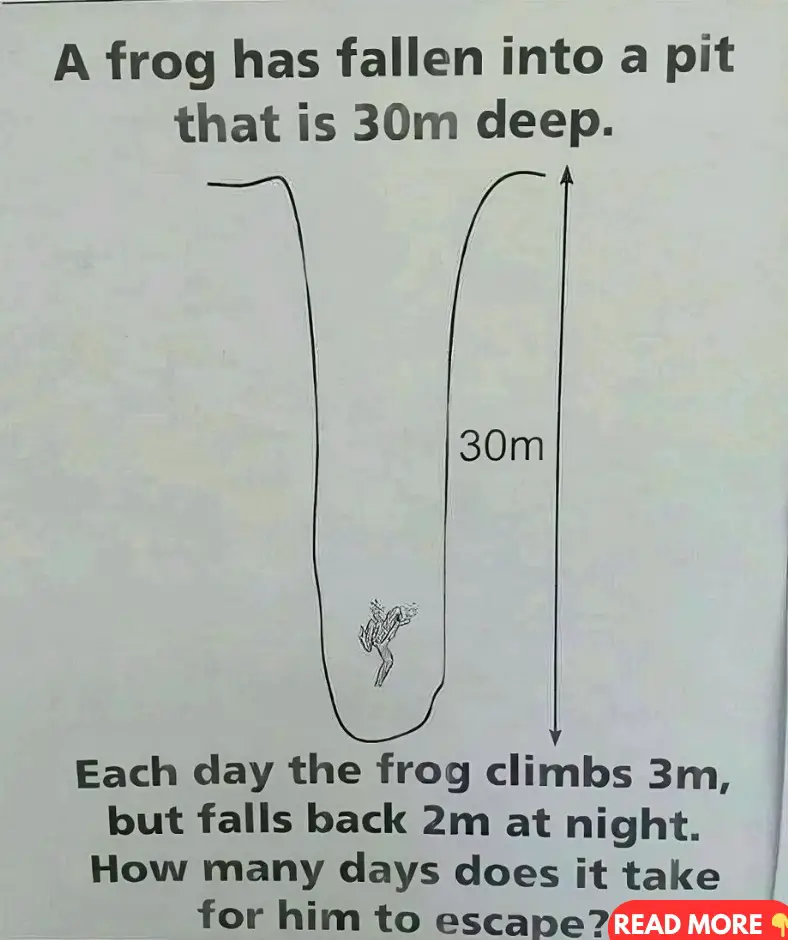The classic “frog in the pit” riddle challenges both children and adults to apply logic and patience. A frog trapped in a 30-meter deep pit manages to climb 3 meters every day, but it slides back 2 meters each night. The question becomes: how many days will it take for the frog to escape? While the answer may seem simple, the riddle encourages complex cognitive functions, demonstrating how riddles and puzzles enhance our problem-solving skills and critical thinking.
The Riddle Explained
This popular riddle serves as more than a fun exercise; it stimulates mental faculties by engaging logical reasoning. Here’s a breakdown: each day, the frog’s net progress is 1 meter (3 meters up minus 2 meters down). This process continues daily, but on the 28th day, the frog climbs the last 3 meters and escapes without sliding back. Thus, it takes 28 days for the frog to escape.
Why Riddles Matter
Riddles are more than brainteasers; they offer a unique opportunity to hone our cognitive abilities. Solving riddles like the frog in the pit reinforces several mental skills:
- Logical Reasoning: Riddles demand step-by-step analysis, helping us understand how one action affects another. For the frog, every gain and subsequent loss must be calculated until the problem is solved. This stepwise approach encourages a logical mindset.
- Creative Thinking: Often, the simplest answer isn’t the correct one. Riddles push us to think beyond our first instinct, engaging creativity to reach a solution that may initially seem counterintuitive. This fosters a flexible thought process, essential for problem-solving in daily life.
- Persistence: The frog riddle metaphorically represents perseverance. Just as the frog doesn’t give up, solving riddles requires patience, teaching us to stay focused even when faced with setbacks.
Expanding Beyond Riddles
Applying the lessons from riddles to real-life situations shows the value of these exercises. For instance, when approaching complex tasks or projects, breaking them down (like calculating the frog’s net progress) can make overwhelming goals more manageable. Additionally, the persistence seen in riddles mirrors what’s needed in problem-solving across various fields, from scientific research to business challenges.
Similar Puzzles to Test Your Skills
If you enjoy the frog in the pit riddle, you may find these puzzles intriguing as well:
- The River Crossing Puzzle: This classic puzzle involves transporting a wolf, a goat, and a cabbage across a river, with the constraint that you can only carry one item at a time and must ensure the goat doesn’t eat the cabbage or the wolf doesn’t eat the goat. The puzzle reinforces planning skills, as each action must be carefully considered.
- The Three Doors Problem: Often presented as a choice between three doors where one hides a prize, this riddle explores probability and decision-making. It’s famously known as the “Monty Hall Problem” and demonstrates the importance of probability in making the best choices.
- The Candle Problem: In this classic cognitive puzzle, you are given a candle, a box of matches, and thumbtacks. The challenge is to attach the candle to a wall in a way that it can burn without dripping wax on the floor. This exercise encourages creative thinking and is frequently used in psychology to study functional fixedness.
Cognitive Benefits of Solving Puzzles
Studies show that regularly engaging with puzzles and riddles can enhance mental agility, improve memory, and even reduce the risk of age-related cognitive decline. Here’s how:
- Enhanced Problem-Solving Skills: Riddles teach us to approach problems from multiple angles, fostering an adaptable mindset that’s valuable in real-world scenarios.
- Memory Boost: Puzzles require us to remember rules, sequences, or details, which can improve short-term memory and recall.
- Reduced Stress Levels: Engaging in a riddle can divert the mind from stress, allowing for relaxation and a break from routine tasks.
Practical Applications of Riddles in Learning and Development
Educational environments are increasingly recognizing the value of puzzles. Teachers and trainers incorporate riddles to make learning more engaging and to encourage analytical thinking among students. Similarly, companies use riddles in interviews to assess problem-solving abilities, particularly for roles that demand quick thinking and creativity.
Conclusion
The “frog in the pit” riddle is more than a simple brain teaser—it’s a powerful metaphor for persistence and a tool for cognitive development. By regularly engaging with such riddles, we train our minds to stay sharp, flexible, and resilient. Whether for fun, education, or professional growth, the value of riddles is undeniable. Next time you face a riddle, remember the cognitive workout it offers.

